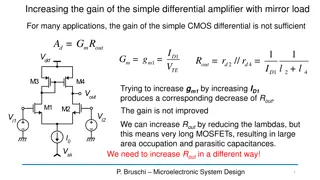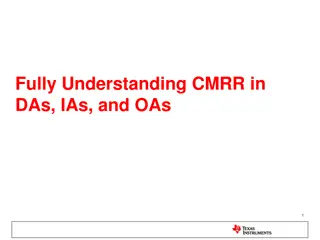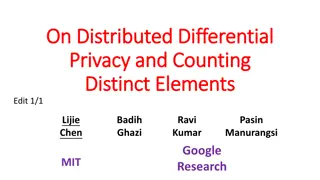Numerical Methods for Approximating Analytic Equations
Introduction to approximating solutions to analytic equations, focusing on differential equations, integral equations, and integro-differential equations. Exploring ordinary and partial derivatives, differential and integral equations, and the involvement of unknown functions and their derivatives a
8 views • 15 slides
Differential Equations of First Order & Higher Degree: Lecture 18
This lecture covers differential equations of first order but not of the first degree, general forms of such equations, methods for solving them, and examples of differential equations to be solved. The content includes detailed explanations, equations, solutions, and problem-solving techniques.
14 views • 9 slides
WBC Differential Count in Blood Analysis
WBC (white blood cell) count is essential in assessing a patient's health. A differential count helps determine the percentage of different types of white blood cells. This analysis can provide important insights into various health conditions like infections, allergies, and systemic illnesses. The
7 views • 9 slides
Differential Leveling in Surveying
Differential leveling is a crucial aspect of surveying that involves determining the elevation of points with respect to a reference datum. This process includes various key elements such as benchmark, back sight, fore sight, and change points. By utilizing methods like the Height of Instrument and
3 views • 12 slides
Techniques to Increase Gain in a Simple Differential Amplifier
Explore methods to boost the gain of a simple CMOS differential amplifier by replacing the current mirror with a cascode mirror, adding a common-gate stage, and employing a cascode differential amplifier. These techniques help improve Rout without extensive use of long MOSFETs, optimizing the amplif
7 views • 30 slides
Differential Equations: Types, Classification, and Solutions
Differential equations are mathematical equations that relate independent and dependent variables through differential coefficients. They can be classified as ordinary or partial, based on the types of derivatives involved. The order and degree of a differential equation, as well as its linearity an
10 views • 26 slides
Differential Equations in Economics Honours
Differential equations, introduced by Newton and Leibniz in the 17th century, play a key role in economics. These equations involve derivatives and represent implicit functional relationships between variables and their differentials, often related to time functions. The order and degree of a differ
4 views • 16 slides
Introduction to Differential Equations and Laplace Equations
Understanding differential equations of various orders, solving methods, linear and non-linear equations, ordinary and partial differential equations, definitions of solutions, and general vs. particular solutions in the context of Differential Equations and Laplace Equations.
8 views • 20 slides
Differential Equations in Physical Phenomena
Differential equations play a crucial role in modeling physical phenomena involving rates of change like fluid motion, mechanical systems, and heat dissipation. This content explores examples of differential equations in motion and provides insights on sketching direction fields using tools like Map
12 views • 11 slides
SymDiff: A Differential Program Verifier
SymDiff is a platform that leverages program verification to analyze program differences, focusing on differential verification to verify properties of program variances rather than the program itself. The architecture, language subset, and modeling imperative programs/heaps are key components discu
7 views • 18 slides
CMRR in Differential Amplifiers
Differential input amplifiers, including operational, instrumentation, and difference amplifiers, play a crucial role in amplifying differential signals while rejecting common-mode noise. The Common-Mode Rejection Ratio (CMRR) is a key parameter in these amplifiers, indicating their ability to suppr
4 views • 48 slides
Applications of Differential Equations in Engineering and Mathematics
Exploring the practical applications of differential equations, specifically focusing on Newton's Law of Cooling and Orthogonal Trajectories. The concept of exact differential equations and their solutions, along with real-life examples demonstrating temperature changes over time, are discussed. Und
5 views • 11 slides
Differential Privacy in Statistical Analysis
Gain insight into the concept of differential privacy in statistical analysis through key terminologies, foundational ideas, and practical examples. Explore the balance between data privacy and statistical quality, and learn how differential privacy serves as a mathematical guarantee to protect indi
3 views • 28 slides
Dynamic Function for Basal Area of Trees Derived from Differential Equation
Mathematical methods presented by Braun and Simmons are used to derive a dynamic function for the basal area of individual trees from a production-theoretically motivated autonomous differential equation. The differential equation and general dynamic function are described, highlighting the relation
3 views • 45 slides
Solving Differential Equations: Methods and Techniques
Learn how to solve differential equations using methods like separation of variables and sketch families of solution curves. Understand the process of finding general and particular solutions to equations, and explore a variety of exercises and examples to enhance your understanding. Master the art
5 views • 16 slides
The Challenges of Protecting Privacy with Differential Privacy
The article discusses the motivation behind using differential privacy to protect sensitive data while enabling useful queries. It highlights the promise of differential privacy, challenges faced, attacks on existing systems like PINQ and Airavat, and introduces a defense system called The Fuzz. The
4 views • 24 slides
Ordinary Differential Equations in Numerical Methods
Delve into the world of Ordinary Differential Equations (ODEs) in numerical methods. Explore how to solve ODEs, assess different techniques' reliability, and choose the right method for various problems. Topics include ODE definitions, order, linearity, solution methods, derivatives, and differentia
3 views • 24 slides
DIFFERENTIAL AMPLIFIER CIRCUIT
The differential amplifier circuit is commonly used in IC units. Learn about single-ended, double-ended, and common-mode operations, along with DC bias and AC analysis. Calculate DC voltages and currents, understand AC voltage gain, and solve examples to comprehend the functioning of a differential
2 views • 9 slides
On Distributed Differential Privacy and Counting Distinct Elements
In this informative content, topics such as the Shuffle Model of Differential Privacy, Lower Bounds for Selection and Learning Parity, and techniques like Moment-Matching and Dominated Protocols are discussed. The concept of Differential Privacy is defined in detail, emphasizing the importance of pr
2 views • 30 slides
COE 526 Differential Privacy Lecture 7 Highlights
Differential Privacy Lecture 7 covers topics like the definition of neighboring databases, randomized algorithms, and differential privacy. It explains how changing input databases affects output statistics minimally and ensures statistical output remains confidential. The lecture illustrates differ
2 views • 17 slides
Separable Differential Equations in Mathematics
Discussing separable differential equations in mathematics, covering topics such as order, degree, separation of variables, and examples to understand the process of finding solutions. Learning outcomes include familiarity with separable differential equations and their solutions.
1 views • 14 slides
Increase Differential Amplifier Gain with Cascode Technique
Explore innovative techniques to enhance the gain of a simple CMOS differential amplifier by implementing a cascode mirror, a differential common-gate stage, and a cascode differential amplifier. Discover how these modifications optimize the performance without compromising on space efficiency or in
1 views • 30 slides
Seminar on Differential Privacy in Fall 19/20 - Insights on Data Privacy Challenges
Explore the challenges of data privacy in the context of differential privacy as discussed in the Seminar on Differential Privacy in Fall 19/20. Learn about reidentification linkage attacks, the anonymization dream, k-Anonymity, and more.
0 views • 31 slides
Aggregation and Transformation of Vector-Valued Messages in Differential Privacy Shuffle Model
Explore the Shuffle Model of Differential Privacy and its aggregation techniques for preserving privacy in data analysis. Learn about the research motivations, models of DP, and the concepts of Differential Privacy.
2 views • 32 slides
Analysis of Second-Order Circuits Using Differential Equations
Explore the systematic analysis of second-order circuits by solving differential equations, finding natural and forced responses, and determining initial conditions. Follow steps for solving by differential equations, such as listing the differential equation, finding responses, and obtaining the co
1 views • 48 slides
Differential Program Verification: Understanding Differences
Explore the concept of differential program verification, where properties of differences instead of programs are verified. Learn about the motivation, research questions, applications, and ongoing progress in this domain. Discover how differential verification can impact software engineering tasks,
1 views • 33 slides
Differential Equations Fundamental Solutions and Theorems
Explore fundamental solutions, Wronskians, and linear independence in ordinary differential equations. Learn about differential operator notation, initial value problems, and unique solution theorems. Examples illustrate the concepts discussed.
3 views • 33 slides
Integration of Ordinary Differential Equations and Chaos in Dynamics
Explore the integration of ordinary differential equations in chemical reactions, fluid mechanics, and quantum mechanics, including examples of ODEs and PDEs. Understand how higher-order ODEs reduce to first-order, initial value problems, autonomous systems, fixed points, and chaos in dynamics. Delv
17 views • 23 slides
Privacy-Preserving Data Release in Differential Privacy
Explore the cutting-edge concept of differential privacy for privacy-preserving data release and mining, focusing on reducing computing complexity and improving signal-to-noise ratio. Learn about generating synthetic data with differential privacy and the challenges in handling high-dimensional data
3 views • 18 slides
Cascode Differential Amplifiers for Increased Gain
Learn about improving the gain of simple differential amplifiers by using cascode mirror loads and adding common gate stages. Explore Cascode Differential Amplifiers, CMOS Cascode Amplifiers, and the input common mode range in microelectronic system design.
4 views • 28 slides
Numeric Solution of Differential Equations in Power System Dynamics
Explore the numeric solution of differential equations in power system dynamics and stability. Learn about differential algebraic equations, ordinary differential equations, equilibrium points, and their stability in power applications. Delve into the computational methods required for analyzing pow
1 views • 39 slides
Delay Differential Equations in Biology: Modeling Biological Systems with Time Delays
Explore the application of delay differential equations (DDEs) in biology, highlighting the importance of capturing time delays inherent in biological processes. Learn about the differences between ordinary differential equations (ODEs) and DDEs, the method of solving DDEs, and models like Lotka-Vol
9 views • 9 slides
CMOS Differential Amplifier with Current Mirror Load for High CMRR and High Gain
Learn about designing a CMOS differential amplifier with current mirror load for achieving high Common Mode Rejection Ratio (CMRR) and high gain, suitable for low supply voltages. The design involves differential to single-ended conversion and maximizing CMRR and gain for optimal performance.
2 views • 28 slides
Applications of Differential Equations in Mathematics
Explore the world of calculus and linear algebra with a focus on differential equations, including Newton's Law of Cooling, LCR circuits, and problems on beams. Understand the concept of exact differential equations and delve into real-life examples. Learn about orthogonal trajectories and their sig
3 views • 11 slides
Ordinary Differential Equations and Orthogonal Trajectories Explained
Explore first-order ordinary differential equations and orthogonal trajectories in mathematics, including concepts like variable separable equations and homogeneous equations. Learn to find orthogonal trajectories of curves and solutions to given differential equations. Practice problems and solutio
11 views • 17 slides
Understanding Differential Forms in the Physical Sciences
Explore the concept of differential forms and their applications in the physical sciences with insights on operators such as gradient, curl, and divergence. Discover the advantages of utilizing differential forms over tensors and delve into curvilinear coordinates and integration methods. Uncover th
0 views • 16 slides
High-Speed Serial Link Layout Recommendations for JESD ADCs and DACs
Learn about the best practices for high-speed serial link layout design when working with JESD ADCs and DACs. Understand the benefits of differential vs. single-ended routing, recommendations for routing of differential traces, handling bends in traces, managing mismatches between individual traces
1 views • 18 slides
Compressed Beamforming Feedback in OFDM Mode: Differential Feedback Method
Explore the application of compressed beamforming feedback in OFDM mode with differential feedback for improved efficiency. The presentation delves into quantization, feedback bits, observation points on channel selectivity, and a proposed method for differential feedback. Discover innovative soluti
2 views • 12 slides
GNSS Positioning Error Budget and Differential Processing
Explore the error budget in GNSS satellite-ground receiver measurements, aiming for sub-centimeter accuracy at 95% confidence. Learn how differential processing enhances accuracy through baseline measurements. Discover the infrastructure requirements for successful differential GNSS processing.
4 views • 19 slides
Differential Amplifier Gain Enhancement Techniques
Explore techniques to increase the gain of a simple differential amplifier with mirror load, including the use of cascode mirror and differential common gate stages to improve output resistance. Discover how a cascode differential amplifier can enhance output resistance and prevent gain decrease due
2 views • 27 slides







































